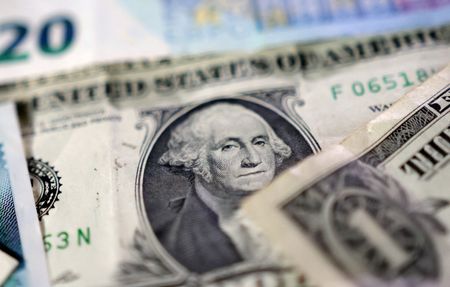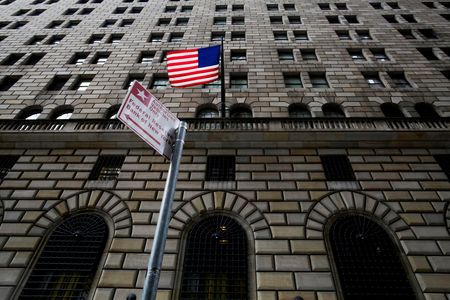By Caroline Valetkevitch
NEW YORK (Reuters) -Longer-dated U.S. Treasury yields rose and the dollar fell on Tuesday as President Donald Trump’s attempt to fire a Federal Reserve governor fueled concerns about the Fed’s independence, while Wall Street stocks were little changed.
Trump on Monday said he was firing Fed governor Lisa Cook over claims of mortgage borrowing impropriety. Cook said that Trump has no authority to fire her from the central bank, and that she would not resign. Her term was due to end in 2038.
The unprecedented move by Trump could lead to a protracted legal battle that risks resetting norms for the central bank’s independence and a president’s involvement in monetary policy. Cook’s exit from the Fed could speed up the president’s reshaping of the rate-setting Federal Open Market Committee.
Trump has been pushing the Fed to lower rates to boost economic growth.
Expectations of a potentially more dovish Fed helped to send shorter-dated yields lower. But a politically influenced Fed that keeps rates lower than they otherwise might could increase concerns over rising inflation and reduce foreign demand for the debt on credibility fears. Those factors will weigh on longer-dated debt.
“President Trump is undertaking a risky and possibly ineffective battle against the Fed. To get a majority of the FOMC to toe the Trump line would take seven voters, not just two or even four,” Brian Jacobsen, chief economist at Annex Wealth Management, wrote in an email.
Trump has regularly threatened to dismiss Fed Chair Jerome Powell, and this month he fired a top Labor Department official after accusing her, without evidence, of manipulating jobs data that had disappointed him. Trump has backed away from that threat as Powell gets closer to the expiration of his term next May.
INFLATION REPORT
The dollar fell against major currencies on the Cook news, and a global stock index was lower as European shares dropped, led by losses in France as political uncertainty deepened in the country. France’s CAC 40 .FCHI fell 1.5% as the country’s minority government looked increasingly likely to be ousted next month.
The S&P 500 was nearly flat, with investors awaiting Nvidia’s NVDA.O results on Wednesday and a key inflation report later this week.
“The market is very much focused on inflation, the labor market, consumer spending and corporate earnings. That – pun intended – trumps everything,” said Oliver Pursche, senior vice president and adviser for Wealthspire Advisors in Westport, Connecticut.
The Dow Jones Industrial Average fell 49.02 points, or 0.11%, to 45,233.45, the S&P 500 rose 1.25 points, or 0.02%, to 6,440.45 and the Nasdaq Composite rose 37.51 points, or 0.18%, to 21,486.80.
MSCI’s gauge of stocks across the globe fell 2.49 points, or 0.26%, to 950.47. The pan-European STOXX 600 index fell 0.69%.
The dollar index, which measures the greenback against a basket of currencies including the yen and the euro,fell 0.3% to 98.17, with the euro up 0.34% at $1.1657. Against the Japanese yen, the dollar weakened 0.14% to 147.54.
The 2-year note US2YT=RR yield typically moves in step with interest rate expectations. It was last down 2.4 basis points on the day at 3.706%. The yield on benchmark U.S. 10-year notes US10YT=RR rose 1.2 basis points to 4.287%.
Investors anxiously await Friday’s U.S. personal consumption prices reading, considered the Fed’s preferred inflation gauge.
Oil prices were lower, while gold rose. U.S. crude fell 1.13% to $64.07 a barrel and Brent fell to $68.08 per barrel, down 1.05% on the day. Spot gold rose 0.34% to $3,377.61 an ounce.
(Reporting by Carolne Valetkevitch and Karen Brettell in New York; Additional reporting by Dhara Ranasinghe in London, Rocky Swift and Kevin Buckland in Toyko; Editing by Helen Popper and Alison Williams)











